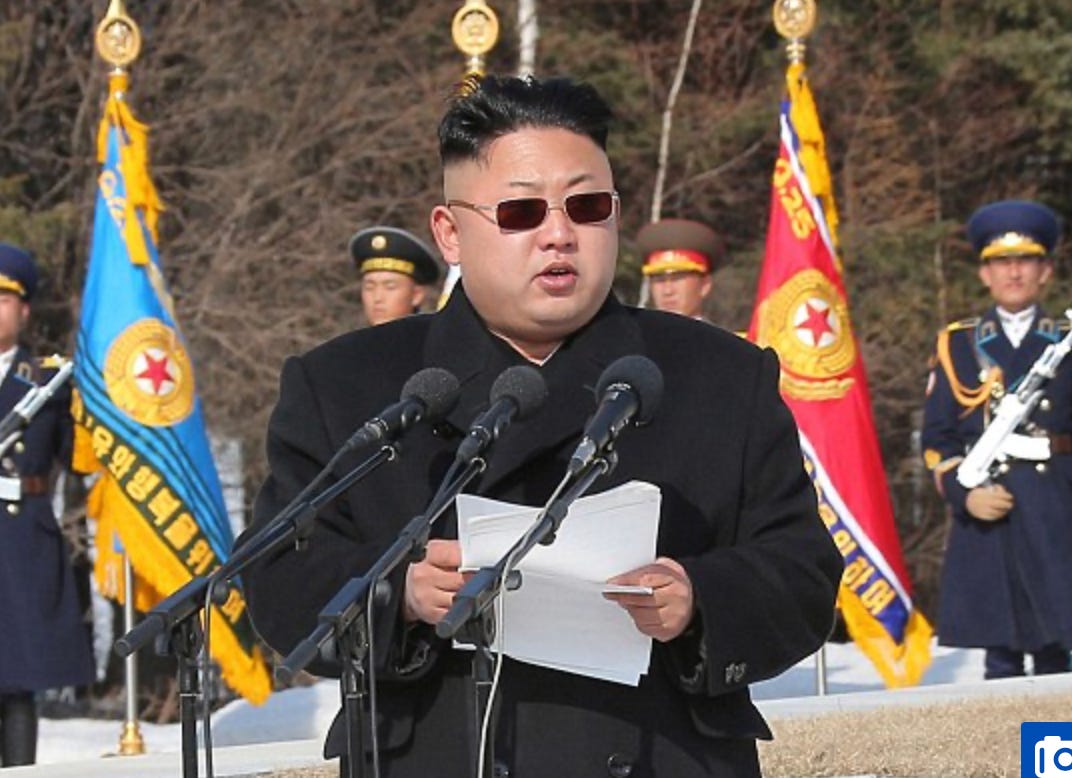Get him out of there, Jill.
I can't take watching these delusional, power-mad idiots put everything at risk.
Last week, the South Korean Ministry of Unification published a compilation of testimonies from 649 North Korean defectors. We learned from these that North Korea recently executed a 22-year-old man for listening to K-Pop. The condemned, according to the judge at the execution site, had listened to 70 South Korean songs.
Under North Korea’s law against “reactionary ideology,” the sentence for spreading culture or information from the outside world is ten years of hard labor. But the punishment for watching or sharing South Korean music is death. You’re shot by a firing squad. The same law prohibits wearing sunglasses, or wearing a white dress for a wedding.
The defectors say the pace of home and mobile phone inspections has quickened. They look for South Korean phrases in texts. Another defector said three people she knew were publicly executed last year for watching South Korean movies.
“It has become quite common,” she said.
North Korea has successfully tested a new tactical ballistic missile capable of carrying an extra-large warhead, its state media said yesterday. It appears to be nuclear-capable. Two days before, it fired two ballistic missiles; one seems to have exploded in mid-air. Unnamed experts, according to the Korea Times, think these missiles may be destined for Russia, for use in Ukraine.
On June 26, the DPRK launched what it said was a separation and guidance control test of individual mobile warheads in its quest to “secure MIRV capability.” This claim, writes Vann H. Van Diepen in 38 North, “appears credible.” The test seems to have failed, although Pyongyang of course claimed otherwise.
“Given the apparent failure,” Diepen writes,
the test’s main significance is in showing that North Korea remains committed to developing multiple-warhead missiles and seemingly believes its efforts are far enough along that a flight test was warranted. The mention of releasing a payload decoy, which is a sensible means of trying to divert missile defenses, is also significant.
“MIRV” stands for “multiple independently targetable reentry vehicle.” A MIRV-capable ballistic missile is a missile that’s launched by a rocket and equipped with more than one warhead, each of which can be directed to its own target. MIRV technology increases the lethality of a first strike. It also increases the odds of overwhelming an enemy’s missile defenses.
The introduction of MIRV technology changes the strategic balance in an arms race. If each missile carries a single warhead, it’s possible, at least theoretically, to use a missile to attack that warhead. Countering a MIRVed missile, however, requires multiple interceptors. This makes it cheaper to attack than it is to defend.
The United States deployed the first true MIRV-capable missile, the Minuteman III, in response to the Soviet Union’s construction of an anti-ballistic missile system around Moscow. It held three held three W62 warheads. Five years later, the Soviets deployed their own, also with three warheads.
Land-based MIRVed missiles are held to be particularly destabilizing because they’re too tempting a target. If you hit them, you can take out multiple warheads at once. To comply with New START treaty, the United States phased out land-based MIRVs in 2014. We kept our SLBMs—submarine launched ballistic missiles—which are believed to be less destabilizing: No one knows where the submarines are, so they can’t hit them.
Russia, however, continues to develop new MIRV-capable ICBMs. One Russian MIRVed missile under development may be able to carry as many as 16 warheads. The coordinates of at least one location in every state in the Union, we assume, have been typed into a Russian ICBM topped by a multi-megaton MIRV.
Fortunately, it isn’t easy to develop MIRV technology. You need large missiles, small warheads, accurate guidance, and a mechanism that directs the warheads to release sequentially. But when North Korea masters MIRV technology, defending South Korea will become much more challenging. Diepen thus assesses that North Korea “will almost certainly continue multiple warhead testing, perhaps relatively soon.” It will take several more years of test flights, however, before North Korea is ready to deploy a MIRVed missile.
“Assistance from Russia or entities in China could accelerate the timeline somewhat,” he adds.
Happily for North Korea, Vladimir Putin and Kim Jong-un signed a mutual defense treaty on June 19. The text of the treaty wasn’t released, so it’s unclear what it really means. But Putin said it provides, “for mutual assistance in the event of aggression against one of the parties to this agreement,” and Kim called it “an alliance.”
“Russia does not exclude for itself the development of military-technical cooperation with the Democratic People’s Republic of Korea,” Putin said.
Before his visit, Putin published an editorial in Nodong Sinmun, the organ of the Workers’ Party of Korea. He lauded North Korea, Russia’s “staunch, like-minded friend and supporter” against “the collective West.” He reminded North Koreans of the support they received from the USSR during the “Patriotic Liberation War of 1950-1953.”
The United States, he expatiated,
… is struggling to impose on the world the so-called rules-based order, which, in fact, is nothing more than a global neocolonial dictatorship based on double standards. … But no matter how hard they try, all their attempts to contain and isolate Russia failed. We continue to confidently increase our economic potential, develop industry, technology, infrastructure, science, education, and culture. … It is gratifying that our Korean friends—despite many years of economic pressure, provocations, blackmail and military threats from the United States—are just as effectively defending their interests. We see with what strength, dignity and courage the people of the DPRK are fighting for their freedom, sovereignty and national traditions. It achieves colossal results, real breakthroughs in strengthening the defense and technological, scientific and industrial power of the country. … Russia has always supported and will continue to support the DPRK and the heroic Korean people in its confrontation with the insidious, dangerous and aggressive enemy …
Kim in turn expressed “unconditional support” for “all of Russia’s policies,” and “full support and solidarity to the Russian government, army and people in carrying out a special military operation in Ukraine to protect sovereignty, security interests, as well as territorial integrity.”
Putin gave Kim a gift: a bulletproof limousine. (Kim loves foreign cars, apparently, and has quite the collection.) They took turns driving as they took it out for a spin.
Pyongyang announced earlier this week that it will send troops to Donetsk to support Russian forces. They’re expected to arrive next month. Since then, Pyongyang has been busying itself sending trash and excrement to the South via balloons. Kim Yo-jong, Kim’s sister, told South Koreans, or as she calls them, “the “scum-like clans of the ROK,” they should regard the balloons bearing filth as “sincere presents to the goblins of liberal democracy.”
As a permanent member of the UN Security Council, Russia helped to design the sanctions imposed on North Korea to stymie its nuclear weapons and ballistic missile research. Now, it’s lobbying internationally to revoke them. Since 2006, a UN-appointed panel of experts has monitored their enforcement. Russia vetoed its annual reauthorization in March.
In the wake of the treaty’s signing, the Institute for National Security Strategy, which is the South Korean government’s think tank, called for Seoul to consider building its own nuclear weapons. This was “extremely unusual,” wrote the Japan Times.
The think tank expressed doubt about the US commitment to deterring North Korea, particularly once North Korea is secure in its ability to strike the US, even more so now that it has secured an alliance with Russia.
Seoul is concerned that Trump will win and revive his love affair with Kim. (Could there be anything more grotesque than an American president saying he “fell in love” with that monstrous slug?) They fear he’ll make a deal that allows him to declare the conflict over, bring back American troops, and leave the DPRK’s nuclear program intact.
You may remember (we wrote about it here) that last year, the Biden Administration issued the Washington Declaration. A nuclear attack by North Korea against South Korea, it said, would be met with “a swift, overwhelming, and decisive response.” It would “result in the end of the Kim regime.” The Administration announced the formation of the Nuclear Consultative Group between the US and South Korea to consider how best to integrate Washington’s nuclear arsenal and South Korea’s conventional capabilities. What this meant was unclear to me; my surmise was this group had been formed so that it could be given a name with the word “nuclear” in it. The point was to reassure Seoul.
They’re not feeling reassured. Who could blame them?
When polled, only 50 percent of the US public says we that if South Korea is invaded, we should defend it. This is down from 63 percent in 2021. South Koreans are watching our presidential campaign. Its leaders must answer to the people. Public pressure is mounting on them.
Would the US protect South Korea? I don’t know. Trump would not, not in a million years. As for Biden, the only good thing that may be said of his debate performance is that we now know exactly why his foreign policy makes no sense, why he never explains it, why no one seems to know what it is, and why critical decisions are so often made a year too late.
Last week, the Nuclear Consultative Group met, for the third time, in Seoul. South Koreans want us to deploy tactical nuclear weapons at the 38th parallel, where they can protect Seoul. But I don’t see how we could. As far as I know, we have about 200 tactical nuclear weapons in our inventory. Half of them are in Europe and the other half are in our strategic reserve in the US. There’s a war in Ukraine. We’re not going to pull them out of Europe.
If South Korea opts for developing an independent nuclear deterrent—and my God, who could blame them—it will trigger a massive nuclear arms race on the Korean Peninsula, which could readily lead to a regional nuclear arms race. This makes the odds of a nuclear war higher. They’re already too high.
None of us know whether anyone would ever be so crazy as to initiate a nuclear exchange. It may be that the reason there hasn’t been one so far is that it’s so insane that no member of our species would ever consider it. The human race has not otherwise discovered depths of depravity to which it will not sink, but perhaps that’s the one thing no one would ever be crazy enough to do.
It’s not much on which to pin your hopes.
Whatever you believe about that, you’ll agree, I’m sure, that people do a hell of a lot dumb things by accident. The risk of accidental nuclear war grows with every new nuclear weapon and every new nuclear power, and that risk is a lot higher than people think:
A nuclear war would be waged with unbelievable speed. The national security reporter Annie Jacobsen published a book recently titled, “Nuclear War: A Scenario.” It’s based entirely on information in the public domain about world’s nuclear arsenals, systems, and doctrines, and as far as I know, while some have criticized its prose (rightly) no one has criticized its accuracy. In interviews, she has said that she hoped the book would have the effect that the airing of The Day After did in the 1980s. (It hasn’t. As I do, she finds it inexplicable that Americans have stopped worrying about this risk even though it has only increased.)
She tells the story of the avionics expert named John Rubel. In 1960, the assistant director of defense research and engineering at the Pentagon received a secret briefing on the American plan for nuclear war.1 At the end of his life, Jacobsen writes, Rubel decided to reveal what he learned:
… “I felt as if I were witnessing a comparable descent into the deep heart of darkness, a twilight underworld governed by disciplined, meticulous and energetically mindless groupthink aimed at wiping out half the people living on nearly one third of the Earth’s surface.”
The Final Solution called for the extermination of all of Europe’s millions of Jews and millions more people the Nazis considered subhuman. The plan for General Nuclear War that Rubel and his colleagues signed off on—the SIOP—called for the mass extermination of some 600 million Russians, Chinese, Poles, Czechs, Austrians, Yugoslavians, Hungarians, Romanians, Albanians, Bulgarians, Latvians, Estonians, Lithuanians, Finns, Swedes, Indians, Afghans, Japanese, and others whom US defense scientists calculated would be caught in the crosswinds.
The Final Solution was enacted. The SIOP never has been—not so far. But a similar, still-classified plan exists today. Over the years, its name has changed. It is now simply the Operational Plan (OPLAN).
The second part of the book is a minute-by-minute account of one plausible scenario for the eruption of nuclear war. It begins when North Korea unleashes a surprise attack, launching an ICBM with a 1-megaton nuclear warhead at the Pentagon, where a technical snafu prevents its interception. In response, the United States launches dozens of Minutemen at North Korea.
The problem is that these must travel over the Arctic Circle and Russia to reach their targets. The President tries to reach his Russian counterpart to ensure no one in Russia will misinterpret this. But relations are frosty. The Russian president is unreachable. Worse, Russia’s notoriously glitchy early warning system, which is apparently in the same condition as the rest of its military, miscalculates the scale of the attack. Believing the missiles are destined for its own cities, Russia launches a massive counterattack, and 92 minutes later, a thousand Russian nuclear warheads have struck the United States.
The worst is still to come. Fires rage throughout the hemisphere, triggering nuclear winter, causing famine everywhere but Argentina and Paraguay. The ozone layer is so damaged that it no longer shields life from ultraviolet rays. When the ground finally thaws, insects and plagues spread from the fields of thawing corpses. It takes 24,000 years for the Earth to recover.
Her scenario, from what I know, is entirely realistic. This is pretty much what would happen.
If our early warning systems signal an incoming attack, the President has only six minutes to decide whether to counter-strike. Failing to do so could cost us all of our land-based nuclear weapons. The governing principle is “use it or lose it.”
In those few minutes, he or she would have to process an urgent, complex and inevitably incomplete stream of information and advice from top defense officials. Jacobsen points out that in such circumstances the president is likely to be subject to “jamming,” a chorus of military voices urging he or she follows protocols which lead inexorably towards a retaliatory launch.
This is the power we propose to put back in Donald Trump’s hands. Trump, recall, is a clinical psychopath. He’s incapable of moral reasoning. If you put his brain in a scanner you’d see nothing but inky darkness between his ventromedial prefrontal cortex and the shriveled pellet where his amygdala should be. He’s got no grey matter between his ventromedial prefrontal cortex and anterior cingulate gyrus. It’s not that he doesn’t choose to empathize with the suffering of others, he’s incapable of it. The only emotions he feels are boredom and rage.2
This is the power right now in the hands of a man who appears to be rapidly declining owing to a neurodegenerative disease. I’m guessing Parkinson’s, but who knows.3 Reports are now suggesting that something is off with the President’s emotions. Fits of rage, they say. So as of now, an octogenarian who is manifestly suffering in multiple cognitive domains (while his entire entourage insists he’s sharp as a fiddle and fit as a tack) would have six minutes to make this decision while suffering from the slowed thinking and information processing we all observed. “Bradyphrenia” is the term of art.
So I guess it will be up to Jill?
In January, if you’ll recall, 38 North published another article that made a brief stir, then faded from attention. Robert Carlin and Siegfried Hecker, who are the furthest thing from amateurs when it comes to North Korea, warned that the situation on the Korean Peninsula was “more dangerous than it has been at any time since early June 1950.”
The evidence of the past year opens the real possibility that the situation may have reached the point that we must seriously consider a worst case—that Pyongyang could be planning to move in ways that completely defy our calculations. Kim and his planners may target the weakest point—psychologically as well as materially—in what the three capitals hope is a watertight US-ROK-Japan military position. The literature on surprise attacks should make us wary of the comfortable assumptions that resonate in Washington’s echo chamber but might not have purchase in Pyongyang. This might seem like madness, but history suggests those who have convinced themselves that they have no good options left will take the view that even the most dangerous game is worth the candle.
The Biden Administration dismissed that warning in much the same way they’re now dismissing the observation that Biden is displaying the florid symptoms of a degenerative disease.
Since the publication of that article, there has been another tragic addition to the literature on surprise attacks. It seems to be quite hard to guard against the wishful thinking that makes decision makers prone to overlooking the warnings.
What a propaganda bonanza all of this has been for Russia and China—and for North Korea and Iran and Hamas and Hezbollah and the long list of groups led by men who like to strangle their enemies with their bare hands, put nerve poison in their enemies’ underwear, slit their enemies’ throats and rape their corpses, or use brainwashed children, strapped with suicide belts, to clear mines.
The images of that debate—and our national discussion of it—could not more perfectly confirm what they wish to believe about the West and what they say to their suffering subjects to justify their misrule. The West is in terminal decline. One more push and it will topple right over. There’s nothing about that system of government you would want: just look at it. China’s propaganda organs didn’t even need to exaggerate:
An American registered voter, 32, told the Global Times on condition of anonymity that neither of the candidates is competent, but what frustrated him most is “they were nominated for a rematch.”
“There must be something wrong with the system.”
Li Haidong, a professor at the China Foreign Affairs University, told the Global Times that there are undoubtedly talented individuals within both parties, but the current party culture makes it difficult for them to emerge. “This is a clear manifestation of the sluggishness, rigidity and lack of vitality in the American political machine.”
Another voter in her 50s used to believe that the US’ democratic system, namely the separation of the three powers, could help fix potential loopholes if a less than ideal candidate is elected. “But the past eight years proved I was totally wrong.”
Said Supervillain Hu Xijin: “Objectively speaking, the low-quality performance of these two old men was a negative advertisement for Western democracy.”
“In America,” sneered Russian talk show host Olga Skabeeva, “a reality show about the life of pensioners became the top rated program of the week, month, or even a year.”
So much for leading with the power of example.
This is almost as painful to watch as the debate itself:
It’s incredible that they’re simultaneously trying to sell the president as the honest candidate and putting on a performance like this.
Odd that we’re not seeing the rats fleeing the sinking ship. Wouldn’t you expect Karine Jean-Pierre to grasp that she’s now reprising Sean Spicer’s most ignominious performances?
“The world is realigning” writes Jonathan Rauch at the Atlantic:
Like a lightning strike illuminating a dim landscape, the twin invasions of Israel and Ukraine have brought a sudden recognition: What appeared to be, until now, disparate and disorganized challenges to the United States and its allies is actually something broader, more integrated, more aggressive, and more dangerous. Over the past several years, the world has hardened into two competing blocs. One is an alliance of liberal-minded, Western-oriented countries that includes NATO as well as US allies in Asia and Oceania, with the general if inconsistent cooperation of some non-liberal countries such as Saudi Arabia and Vietnam: a Liberal Alliance, for short. The other bloc is led by the authoritarian dyad of Russia and Iran, but it extends to anti-American states such as North Korea, militias such as Hezbollah, terrorist organizations such as Hamas and Palestine Islamic Jihad, and paramilitaries such as the Wagner Group: an Axis of Resistance, as some of its members have accurately dubbed it. …
Russia has ditched its previously warm relationship with Israel to embrace Iran, which supplies the Kremlin with weaponry and equipment. North Korea likewise supplies the Russian war effort, and it recently entered into a security pact with Russia; Hamas praises North Korea as “part of [our] alliance.” China, while keeping some distance from the Ukraine conflict militarily, has declared “unlimited partnership” with Russia, helps Russia defeat economic sanctions, and provides industrial and technological support for Russia’s war effort. Meanwhile, Russia props up the pro-Iran regime in Syria, and militias aligned with Iran use missiles and drones to strike Israel from Gaza and Lebanon, US forces from Iraq and Syria, and Saudi Arabia from Yemen. Even the weakest and poorest of the Axis forces, the Houthi rebels in Yemen, disrupt regional shipping virtually at will.
He is alarmed, but not alarmed enough. This axis, he writes, “may well succeed in weakening NATO, dominating the Middle East, and, what is perhaps most significant, calling into question the sustainability of Western-style liberalism,” he writes.
It “may?” It has.
“The rush to form alliances is always a bad sign,” writes Paul Poast in a surprisingly good article in World Politics Review:
… The historian William Langer observed long ago that rapid movements toward alliance formation and consolidation often precede the outbreak of major wars. … It would not be off base to draw comparisons to the diplomatic situation in Europe on the eve of World War I, when France complemented its alliance with Russia by signing an agreement, or entente, with Britain. The resulting “Triple Entente” bloc then stood in opposition to the Triple Alliance of Imperial Germany, the Austro-Hungarian Empire and Italy. Similarly, the eve of World War II witnessed the signing of the Nazi-Soviet Non-Aggression Pact, a defense pact between Britain and Poland, the Axis pact between Nazi Germany and Italy and their subsequent Tripartite Pact that included Japan, as well as a reaffirmation of the bonds between France and Britain.
That’s quite true.
Antisemitism, too, is always a bad sign. It’s commonly said that Jews are the canary in the coal mine. It’s rather a revolting cliché, in as much as it suggests the only reason to be concerned about the persecution of Jews is not because Jews are being persecuted, but because you’re apt to be persecuted next. But it is also quite true: Antisemitism becomes virulent in destabilized societies; it is a harbinger of democratic collapse, and it does mean you’re apt to be persecuted next.
Why exactly the relationship between antisemitism and political breakdown should be so strong is unclear. Perhaps it’s because its rise signals a breakdown in moral norms and intellectual standards. Perhaps it’s because conspiracy theories take hold at moments of suspicion and uncertainty. Whatever the case, it’s another light flashing red.
One after another window of hope is closing. The Supreme Court? It’s gone mad. Its verdict in Trump v. United States is insane. If you’re worried about the Orbánization of the United States, the train has already left the station.
It’s not so bad, you say? Just wait. They have declared this man will be our King:
I don’t know which is more appalling. Trump, or the sinister figures around him. Unlike him, they are purposeful and organized. The Supreme Court has passed their Enabling Act. They’re so confident now that nothing stands between them and their Gleichschaltung that they openly say things like this:
Since that debate, and the more I think about it, the more incandescent with rage I’ve become. Biden and the people around him—through vanity, power-lust, self-delusion, or outright mendacity—have put America and the world in unspeakable danger. The situation we face is more perilous now than it was even in 1939, because there are so many nuclear weapons, distributed among so many unstable players; and the instability is all the more alarming because no one in our government seems fully to grasp the dangers we’ve unleashed with artificial intelligence and biotechnology.4 Simultaneously, we face our moment of greatest peril at home. We now have almost no hope of preventing a second Trump presidency.
The Administration has been telling the truth about the threat Donald Trump represents. His reelection would be a Republic-destroying calamity. None of what he says is an empty threat. He will be King, and a hell of a lot madder than George III.
But because the Administration is so obviously lying about a matter of utmost national interest, they’ve lost not only the moral authority to make this argument but the hope of being believed when they do. They’ve all but ratified every crazy fantasy and lie bubbling and belching out of MAGA Gehenna.
I am furious at them all. J’accuse. The sight of every one of our gerentocrats makes me want to vomit. Go to hell, Karine Jean-Pierre—you think it’s appropriate to wearily roll your eyes at us that way? And for the love of God, stop bringing up abortions every time you’re asked about the President’s marbles. You could perform an abortion right there at the podium and it still wouldn’t put us off the scent. Go to hell, Jill Biden—the cover of Vogue? Seriously? We’ve got Marie Antoinette, Imelda Marcos, Lady Macbeth and Edith Wilson all rolled into one, here, striking a pose between urging us to vote and asking the President if he needs to go potty. Go to hell, bright spark who decided to announce Biden is busy today with an Annie Liebowitz photo shoot. Go to hell, Merrick Garland—you, especially, you timorous wimp.
Go to hell, Clarence Thomas. Go to hell, Sam Alito. Go to hell, John Roberts. Go to hell, Mitch McConnell. To hell with every last member of the preposterous, servile, degenerate GOP. To hell with FOX news, Michael Flynn, Roger Stone, Tucker Carlson, and Steve Bannon. To hell with Kevin Richards and the Heritage Foundation. To hell with every single Fox News fawner and flatterer who has the temerity to bray about the Democrats’ circling the limos to protect their unfit candidate. Clean up your own pigpen. I don’t want to hear another word from your canting, sanctimonious yap-holes.
To hell with Democrats who are “leery of going public” with their concerns about the president. For eight years running, Republicans “leery of going public” have been leaking that Trump is a dangerous fool, and Democrats rightly described them as cowardly bootlickers, lickspittles, and Uriah Heeps. Now that the licked boot is on the other foot, how does it taste? Mmmm, good? Sure looks like you like gobbling it down.
To hell with every last journalist who is trying to paper this over. To hell with Jen Rubin. The stupidity of suggesting that “white males” are just making a fuss over Biden’s incapacity because they “publically [sic] freak out when things dont [sic] go just so” is so pure that if I weren’t so furious, I’d probably admire it as a kind of perfection in the work.
To hell with every journalist who’s written, this week, that actually, the ability to verbalize isn’t that important in a president. It’s just speaking. He’s terrific at the rest of the job. Do you realize how you sound?
Go to hell, Claudine Gay. Take the whole academy with you.
To hell with the lot of you. Everyone who’s destroying the world’s noblest democratic experiment. You are obscenely reckless with something infinitely precious and irreplaceable in the world. You make me sick.
Rubel was later to serve as Kennedy’s defense under secretary. However disturbed the presentation left him, it clearly didn’t cause him to concluded he wanted no part of it.
The Hare Psychopathy Checklist has been shown to be extremely accurate in diagnosing psychopathy as well as predicting future psychopathic behavior. It is quite simple. Each item on the checklist is given a score between zero and two:
Glibness-superficial charm
Grandiose sense of self-worth (narcissistic psychopath)
Need for stimulation
Pathological lying
Conning-manipulative
Lack of remorse or guilt
Shallow affect
Callous-lack of empathy
Parasitic lifestyle
Poor behavior controls
Promiscuous sexual behavior
Early behavioral problems
Lack of realistic, long-term goals
Impulsivity
Irresponsibility
Failure to accept responsibility
Many marital relationships
Juvenile delinquency
Revocation of conditional release
Criminal versatility
The highest possible score is forty. Thirty points or above is considered a psychopath. People with no criminal background tend to score about five; criminals who are not psychopaths tend to score about 22. “Lacking in conscience and empathy, they take what they want and do as they please, violating social norms and expectations without guilt or remorse.”
“That’s quite a lot of diagnosing you’re doing there, Claire, especially given you’ve not spent so much as a minute in medical school.” True. But sometimes things are pretty damned obvious, and if no one more qualified is willing to make these observations publicly, I figure someone should. Parkinson’s is hard to diagnose in its early stages, which is why his doctor missed it in February, I figure. (This is the very charitable interpretation.) Bradykinesia is a frequent symptom of Parkinson’s.
“ … In addition to a general slowness of movement, the bradykinesia of Parkinson’s disease is typically demonstrated by a reduced or mask-like expression of the face (hypomimia or facial masking), a decreased blink rate of the eyes, and problems with fine motor coordination.” Blinking can slow from 16-18 times per minute to 1-2 times per minute.
“ … Changes in the voice are commonly experienced. These are believed to be at least partly due to bradykinesia. The voice may become softer, or it may start off strong and then fade away. There may be a loss of the normal variation in volume and emotion in the voice, so that the individual may speak in a monotone. In more advanced Parkinson’s, speaking may become rapid, with the words crowded together, or stuttering may occur.” ….
“ … Bradykinesia and postural instability both contribute to walking—or gait—difficulties in Parkinson’s, particularly as the disease progresses. A common, early symptom of Parkinson’s disease is a decrease in the natural swing of one or both arms when walking. Later, steps may become slow and small, and a shuffling gait (festination) may appear.” …
“ … People with advanced Parkinson’s disease may experience episodes of freezing, in which the feet appear to be glued to the floor.” …
“ … Particularly in more advanced Parkinson’s disease or in older people with the disease, problems with thinking, word finding, and judgment are common.” .
“More pronounced in the later stages, postural instability includes the inability to maintain a steady, upright posture or to prevent a fall. Such balance problems in Parkinson’s disease are associated with a tendency to list or fall backward (retropulsion) … ”
Sound like anyone you’ve seen recently?
Unfortunate timing for this announcement:
More:
The cross-sectional proportion of patients with PD who have dementia is 24–31 percent. Although findings vary among studies, the cumulative prevalence of PD dementia in patients with a mean age at diagnosis from 54 to 70.2 years is 17 percent at 5 years after diagnosis, 46 percent at 10 years after diagnosis and 83 percent 20 at years after diagnosis, compared with a global prevalence of 5–7 percent of dementia in the general population >60 years of age. Thus, despite variability, there is a high risk of dementia in PD, with nearly half of patients having dementia within 10 years after diagnosis and the vast majority of patients having dementia within >20 years after diagnosis.
Now of course, I can’t say for sure what’s wrong with Biden. Many other diseases, none of them good, could be causing those symptoms. He could be suffering from multiple system atrophy, dementia with Lewy bodies, progressive supranuclear palsy, corticobasal ganglionic degeneration, the long-term consequences of two brain aneurysms, or, apparently, a “bad night.” Here’s the key point: If your “bad nights” perfectly mimic Parkinson’s disease, you have no business holding the power to melt the world in your trembling hands.
If it was really “a bad night,” this discussion would be over already, because Biden would have spent the week making the kinds of public appearances that would countermand the impression he has given us. He has not. He has not been seen without his teleprompter. There would not now be leaks from every orifice that yes, actually, he’s often like that, especially between the early afternoon and the late morning. He wouldn’t be attributing his performance to jet lag, given he hadn’t been inside a jet for two weeks on the night of the debate. Above all, he would have by now undergone a complete cognitive and neurological workup, then shared every detail of the results with the public, along with the second opinions of a team of independent specialists. He has not.
(Also, he’d have announced that he’s ordered Seal Team 6 to take care of Trump the minute that verdict came down. What a tragedy to be declared the first King of the United States but be too gaga to enjoy it.)
Our enemies—and they are enemies —do not share our scruples about diagnosing from a distance. Their intelligence services have been analyzing every frame of that debate. They have not accepted the explanation that this was merely “a bad night,” because only a fool would believe a “bad night” causes those symptoms. They’re right now trying to decide how best to exploit this, because luck like this doesn’t come around twice in a lifetime.
Congratulations to the Supreme Court on its wise decision to kill Chevron deference at exactly the moment we have a geriatric Congress that struggles to understand TikTok coupled with the most technically complex and urgent regulatory challenges we’ve ever faced. Good thing nothing could possibly go wrong.






















« The same law prohibits wearing sunglasses, or wearing a white dress for a wedding. » but Kim would look great in a white dress 😂😂
Sorry - I know this is all serious but it was the first thing I thought of. Your entire hell rant really resonates. Where are all the grown ups?!?
“There must be something wrong with the system.”
There is nothing wrong with the system. There is something wrong with us.